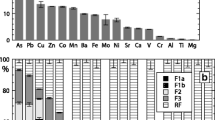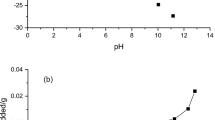Abstract
A sequential extraction procedure was carried out in columns using reagents that are known to be reliable from batch tests. The intention was to distinguish between different chemical forms of iron and heavy metals in samples from reduced porous aquifers, which demands anaerobic conditions for the extraction procedure and the determination of small amounts of reactive mineral phases in a quartz dominated sediment system. By means of the developed method, anaerobic conditions can be guaranteed in the columns, which could not be realized to full satisfaction in batch tests that were carried out in a glove box. In order to distinguish between the fractions that were water soluble, exchangeable, bound to carbonates and bound to hydroxides, different reagents were pumped through the sediments and sampled after passage of the columns. Sediment samples of 10 kg each were investigated in this way. The extraction steps were known to be complete when analyses revealed that no further major and trace elements were leached out of the columns. This approach enabled well-adjusted amounts of reagents to be used. By means of the sequential extraction procedure in columns the composition of even small amounts of reactive mineral phases can be determined successfully, which contributes to a deeper understanding of the hydrogeochemical processes in aquifers. In batch tests this accuracy cannot be reached because of the surplus of the extraction solution in relation to the amount of sediment (higher solution-sediment ratio). Furthermore, larger samples are much more representative of the composition of the aquifers than smaller ones and the heterogeneity of the sediment does not limit the accuracy of the results as much as in batch tests. In addition, the technique of flushing sediment in a column is much more typical for the situation in an aquifer than suspending a few grams of a sample in the extracting reagents in batch extraction tests. In order to demonstrate the methodical improvements and field applications, the newly developed method was used to investigate the changing binding forms and mobility of iron and trace metals in samples from a lignite overburden dump, which are influenced by pyrite oxidation processes (acidification) followed by the addition of crushed limestone (neutralization) (see "Sequential extraction procedure in columns. Part 2: Application of a new method").





Similar content being viewed by others
References
Böhler S, Piotrowski JA, Scheytt T (1995) Bindungsformanalyse von Feststoffproben aus dem hydrogeologischen Testfeld Belau (Schleswig-Holstein). Meyniana 47:1–20
Broers H-P (1998) Release of Ni, Co and As from aquifer sediments at the Oostrum well field. Tübinger Geowissenschaftliche Arbeiten, Reihe C: Hydro-, Ingenieur- und Umweltgeologie 36:106–108.
Brümmer GW, Gerth J, Herms U (1986) Heavy metal species, mobility and availability in soils. Z Pflanzenernähr Bodenkd 149(4):382–398
Calmano W, Förstner U (1985) Schwermetall-Bindungsformen in Küstensedimenten — Standardisierung von Extraktionsmethoden. Forschungsbericht; Bundesministerium für Forschung und Technologie Germany, M 85-004, 183 pp
Cremer N (2002) Schwermetalle im Grundwasser Nordrhein-Westfalens unter besonderer Berücksichtigung des Nickels in tieferen Aquiferen der Niederrheinischen Bucht. Besondere Mitteilungen zum Deutschen Gewässerkundlichen Jahrbuch 60, 178 pp
Deutscher Normenausschuß (ed) (1984)DIN 38414, Teil 4- Bestimmung der Eluierbarkeit mit Wasser (S 4). Deutsches Institut für Normung e.V., Berlin, Germany
Dües G (1987) Untersuchungen zu den Bindungsformen und ökologisch wirksamen Fraktionen ausgewählter toxischer Schwermetalle in ihrer Tiefenverteilung in Hamburger Böden. Hamburger Bodenkundliche Arbeiten 9, 265 pp
Förstner U, Calmano W (1982) Bindungsformen von Schwermetallen in Baggerschlämmen. Vom Wasser 59:83–92
Förstner U, Patchineelam SR (1976) Bindung und Mobilisation von Schwermetallen in fluviatilen Sedimenten. Chem Zeit 100:49–57
Jackson ML (1958) Soil chemical analysis. Prentice Hall, London
Parkhurst DL (1995) PHREEQC—a computer program for speciation, reaction-path, advective transport, and inverse geochemical calculations. US Geological Survey Water Resources Investigation Report 95-4227, Lakewood, Colorado, 143 pp
Peula Lopez FJ (1995) Bindungsformen von Schwermetallen in anoxischen Fluß-Sedimenten: Ein Vergleich verschiedener Extraktionsverfahren. Thesis, University of Heidelberg, Germany, 170 pp
Sposito G, Lund LJ, Chang AC (1982) Trace metal chemistry in arid-zone field soils amended with sewage sludge: 1. Fractionation of Ni, Cu, Zn, Cd and Pb in solid phases. Soil Sci SocAm J 46:260–264
Tessier A, Campbell PGC, Bisson M (1979) Sequential extraction procedure for the speciation of particulate trace metals. Anal Chem 51(7):844–851
Von Lührte R (1997) Verwertung von Bremer Baggergut als Material zur Oberflächenabdichtung von Deponien — Geochemisches Langzeitverhalten und Schwermetall-Mobilität (Cd, Cu, Ni, Pb, Zn). Berichte aus dem Fachbereich Geowissenschaften der Universität Bremen 100, 148 pp
Wisotzky F (2001) Preventation of acidic groundwater in lignite overburden dumps by the addition of alkaline substances: Pilot-scale field experiments. Mine Water Environ 20:122–128
Wisotzky F (2003) Saure Bergbauwässer (Acid Mine Drainage) und deren Qualitätsverbesserung durch Zugabe von alkalisch wirkenden Zuschlagstoffen zum Abraum. Besondere Mitteilungen zum Deutschen Gewässerkundlichen Jahrbuch 61, 167 pp
Wisotzky F, Kringel R (1998) Möglichkeiten der Sanierung saurer Grundwässer durch induzierte pH-pe-Veränderungen in Braunkohlenabraumkippen. In: Dresdner Grundwasserforschungszentrum (eds) Proceedings der 6. Dresdner Grundwasserforschungstage 1998, Dresden, pp 111–121
Zeien H, Brümmer GW (1989) Chemische Extraktionen zur Bestimmung von Schwermetallbindungsformen in Böden. Mitteilungen der Deutschen Bodenkundlichen Gesellschaft 59, I, pp 505–510
Acknowledgement
The results presented were obtained in two comprehensive projects funded by RWE Rheinbraun AG (Cologne), Niederrheinische Versorgung und Verkehr AG (Mönchengladbach), Niederrheinwerke Viersen AG (Viersen) and the Environmental Protection Agency/NRW (LUA/NRW, Essen).
Author information
Authors and Affiliations
Corresponding author
Rights and permissions
About this article
Cite this article
Wisotzky, F., Cremer, N. Sequential extraction procedure in columns. Part 1: Development and description of a new method. Env Geol 44, 799–804 (2003). https://doi.org/10.1007/s00254-003-0800-7
Received:
Accepted:
Published:
Issue Date:
DOI: https://doi.org/10.1007/s00254-003-0800-7




